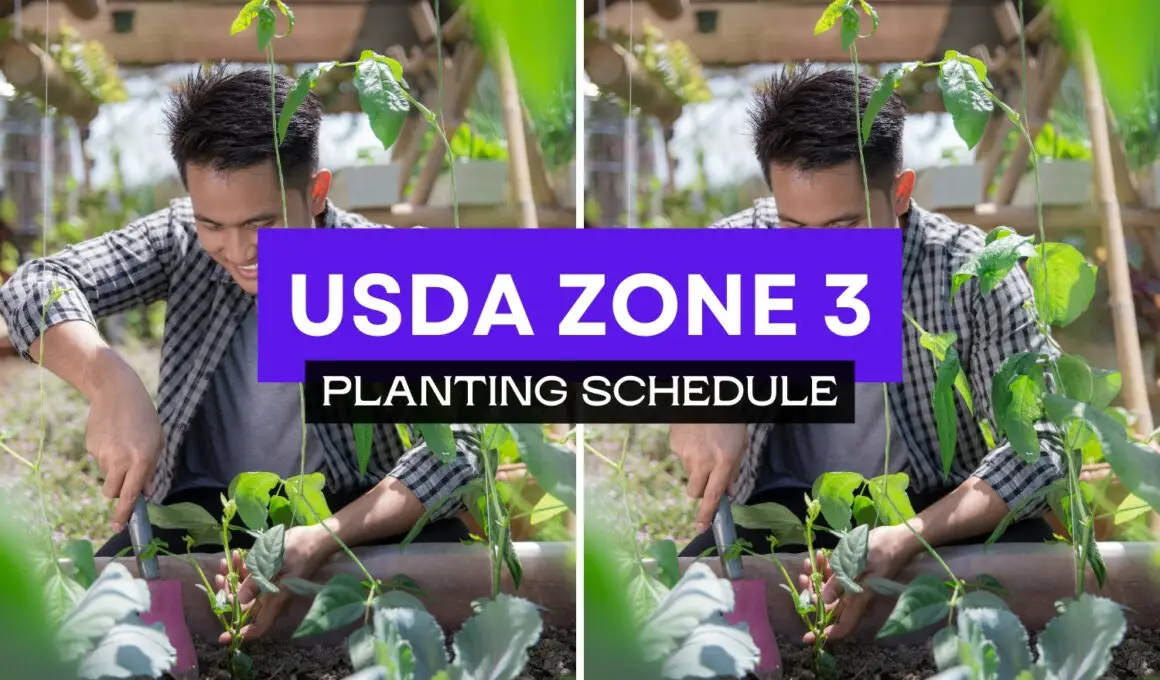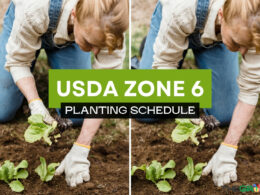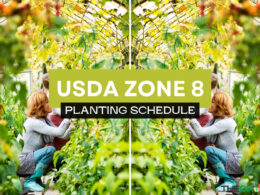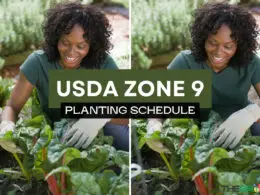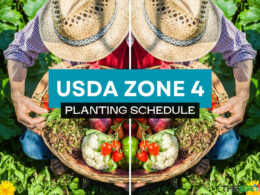In This Article Show
Welcome to the ultimate guide for Zone 3 planting schedules, carefully crafted for gardeners navigating the unique challenges of one of the coldest climates in the gardening world. With its notably short growing season and long, harsh winters, Zone 3 gardening requires meticulous planning, timely execution, and a keen selection of plant varieties that can thrive under these conditions.
This guide aims to arm you with the knowledge and strategies needed to extend your growing season, protect your plants from frost, and achieve a bountiful harvest and vibrant blooms. Whether you’re looking to cultivate hearty vegetables, stunning flowers, or both, our month-by-month breakdown and tailored tips will help ensure your garden not only survives but thrives in the cool climate of Zone 3.
Embrace the challenge and discover the joys of gardening in Zone 3, where every day of growth is a triumph and every harvest a victory against the elements. Let’s delve into how to maximize your gardening success in this brisk environment.
Key Factors for Success in Zone 3
Gardening in Zone 3 presents unique challenges due to its short growing season and long, cold winters. However, with careful planning and the right strategies, you can cultivate a thriving garden. Here are the key factors for success:
Selecting Frost-Tolerant and Quick-Maturing Plant Varieties
- Frost Tolerance: Choose plants that can withstand unexpected frosts, a common occurrence in Zone 3. Vegetables like kale, brussels sprouts, and some varieties of peas and spinach are known for their frost tolerance.
- Quick Maturation: Opt for plant varieties that mature quickly, ensuring they can be harvested before the onset of early frost. Look for vegetables and flowers with “early” or “short season” in their descriptions, as these are bred for rapid growth and development.
Strategies for Soil Preparation and Improvement in Cold Climates
- Soil Warming: Use black plastic mulch, cloches, or floating row covers to warm the soil before planting. Warmer soil temperatures can help seeds germinate more quickly and extend the growing season.
- Organic Matter: Incorporate plenty of compost and well-rotted manure into your garden beds to improve soil structure, fertility, and water retention. This is particularly important in Zone 3, where soils can be heavy and cold.
- Drainage: Ensure good drainage in your garden beds. Cold, wet soils can delay planting and harm seedling development. Raised beds can be an effective solution to improve drainage and soil warmth.
Utilizing Season Extenders like Cold Frames and Greenhouses
- Cold Frames: These simple structures can protect plants from frost, allowing you to start your garden earlier in the spring and extend it later into the fall. They’re ideal for hardening off seedlings or protecting cold-tolerant crops.
- Greenhouses: A more substantial investment, greenhouses can dramatically extend your growing season. Even an unheated greenhouse can provide a suitable environment for growing a variety of plants well beyond the natural outdoor growing season in Zone 3.
- Floating Row Covers: Lightweight and easy to use, floating row covers can protect plants from frost without the need for a structured frame. They allow light and water to reach the plants while providing a few degrees of temperature moderation.
Additional Tips for Gardening Success in Zone 3
- Microclimate Exploitation: Take advantage of microclimates within your garden, such as planting in sunny spots protected from wind, to maximize warmth.
- Soil Testing: Early in the season, test your soil to tailor your fertilization strategy to the specific needs of your plants, ensuring optimal growth.
- Pest and Disease Management: Due to the condensed growing season, it’s crucial to monitor for pests and diseases closely and act quickly to mitigate any issues.
By focusing on these key factors, gardeners in Zone 3 can overcome the challenges posed by the climate and enjoy a productive garden. With the right plant selections, soil preparation, and the use of season extenders, you can extend your growing season and maximize your garden’s potential.
Zone 3 Planting Schedule: Month-by-Month Guide
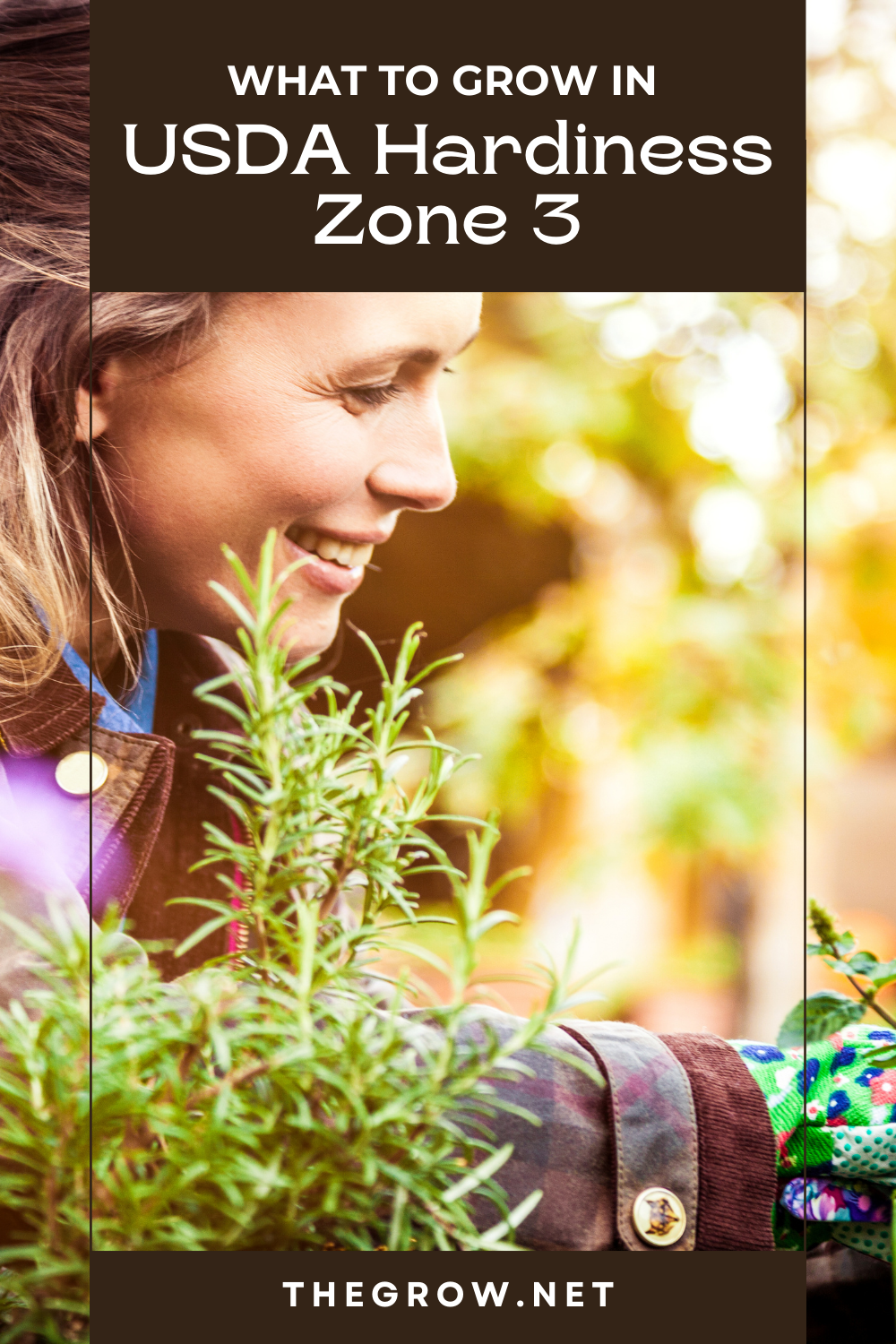
Spring (April – May)
Get Gardening For Beginners
Our new EBOOK shows newcomers and green thumbs alike a step by step guide to growing the garden of their dreams.
Ideal Vegetables and Flowers to Start Indoors and When to Transplant Outdoors
- Vegetables: Start seeds indoors for tomatoes, peppers, and broccoli in April. Transplant outdoors in late May or early June, after the last frost.
- Flowers: Begin seeds for marigolds, petunias, and pansies indoors. They can be moved outside once the danger of frost has passed.
Preparation for Spring Planting, Including Soil Warming Techniques
- Soil Warming: Use black plastic mulch or fabric covers on garden beds a few weeks before planting to increase soil temperature.
- Soil Preparation: Amend soil with compost and well-rotted manure to improve fertility and drainage. Test soil pH and adjust as necessary.
Summer (June – August)
Recommendations for Direct Sowing Summer Crops and Flowers
- Vegetables: Direct sow seeds for carrots, beets, and lettuce in early June. Consider quick-maturing varieties for a successful harvest.
- Flowers: Sow sunflower, cosmos, and zinnia seeds directly into the garden as they thrive in the warmth of Zone 3 summers.
Mid-Summer Planting for Fall Harvest and Continuous Blooms
- Late Planting: In July, plant a second round of fast-growing vegetables like spinach and radishes for a fall harvest.
- Continuous Blooms: Deadhead flowers regularly to encourage new growth and plant additional annuals if desired for extended color.
Maintenance Tips Including Watering, Pest Control, and Disease Management
- Watering: Establish a consistent watering schedule, especially during dry spells. Early morning watering is most effective in reducing evaporation.
- Pest Control: Monitor plants closely for pests. Use physical barriers or organic pesticides as needed to protect your garden.
- Disease Management: Promote good air circulation around plants to prevent fungal diseases. Remove and dispose of any diseased plant material promptly to prevent spread.
This planting schedule for Zone 3 takes advantage of the region’s distinct seasons, from the careful planning and indoor start in spring to the direct sowing and maintenance of summer crops and flowers. By following these guidelines, gardeners can navigate the short growing season effectively, ensuring a productive garden filled with fresh vegetables and vibrant blooms.
Fall (September – October)
Fall Planting Opportunities for Late-Season Crops and Perennials
- Late-Season Crops: Sow seeds for cold-hardy vegetables like kale, spinach, and Swiss chard in early September for a late fall harvest. Garlic cloves can also be planted in October for harvesting the following summer.
- Perennials: Plant hardy perennials, including daylilies, peonies, and hostas. Fall planting allows them to establish roots before the winter, ensuring stronger growth in spring.
Preparing the Garden for Winter, Including Mulching and Protective Coverings
- Mulching: Apply a thick layer of mulch around perennials, shrubs, and over garden beds to protect plant roots from freezing temperatures and to preserve soil moisture.
- Protective Coverings: For particularly sensitive plants, use burlap or frost cloth coverings to provide extra insulation against cold weather.
- Garden Cleanup: Remove spent annuals and vegetables to reduce the risk of pests and diseases overwintering in the soil. Clean and store garden tools properly.
Winter (November – March)
Planning and Ordering Seeds for the Next Growing Season
- Seed Catalogs: Spend the winter months browsing seed catalogs and online resources. Make a list of desired plants, keeping in mind the short growing season and cold tolerance necessary for Zone 3.
- Garden Planning: Sketch out your garden layout, considering crop rotation and companion planting to maximize space and minimize pest and disease issues.
Winter Projects, Such as Building or Improving Garden Structures
- Cold Frames and Greenhouses: Consider building or improving structures like cold frames or greenhouses to extend your growing season next year.
- Garden Infrastructure: Winter is an excellent time to build or repair garden beds, trellises, and paths, as well as to maintain gardening tools and equipment.
Additional Winter Tasks
- Soil Care: If the ground is not frozen, take the opportunity to add compost or manure to your garden beds, allowing nutrients to integrate into the soil over winter.
- Wildlife Support: Consider setting up bird feeders to support local wildlife during the cold months, and plan your garden to include plants that provide habitat and food for birds and beneficial insects.
By utilizing the fall to prepare your Zone 3 garden for winter and planning during the colder months, you can set the stage for a successful and productive gardening season come spring. Taking advantage of the dormant period to improve garden structures and plan your plantings ensures you’re ready to hit the ground running when the growing season returns.
Vegetable Planting Guide for Zone 3

In Zone 3, the growing season is short, making it essential to select vegetables that can mature within a limited timeframe or withstand frost. Below is a chart of common vegetables suitable for Zone 3, including their optimal planting times and tips for success.
| Vegetable | Optimal Planting Times | Success Tips |
|---|---|---|
| Peas | As soon as the soil can be worked in spring | Use inoculant to boost growth. Provide support for climbing varieties. |
| Lettuce | Early spring and again in late summer for a fall crop | Choose heat-tolerant varieties for summer planting and use shade covers if necessary. |
| Spinach | Early spring and again in late summer | Use floating row covers to protect from frost and extend the growing season. |
| Radishes | Early spring and again in late summer | Radishes mature quickly; plant in succession every two weeks for a continuous harvest. |
| Carrots | Early spring | Use a fine seedbed and keep moist for best germination. Consider using a polytunnel or cold frame for early starts. |
| Kale | Early spring and again in late summer | Kale can withstand frost, making it ideal for extended harvesting into fall. |
| Potatoes | After the danger of frost has passed | Hill soil around the plants as they grow to increase yield and prevent greening. |
| Beets | Early spring and again in late summer | Keep soil consistently moist for even root development. |
| Broccoli | Start indoors 4-6 weeks before the last frost; transplant outdoors after the danger of frost has passed | Use row covers to protect from pests and frost. |
| Cabbage | Start indoors 4-6 weeks before the last frost; transplant outdoors after the danger of frost has passed | Plant in a spot that gets full sun and has fertile, well-drained soil. |
| Swiss Chard | Early spring and again in late summer for a fall crop | Chard is cold-tolerant and can be harvested well into the fall. |
| Garlic | Plant cloves in October for harvest the following summer | Choose hardneck varieties for cold tolerance. Mulch heavily for overwintering protection. |
Success Tips for Vegetable Gardening in Zone 3
- Start Seeds Indoors: To extend the growing season, start seeds indoors for warmth-loving vegetables like tomatoes and peppers, then transplant them outdoors when the weather warms.
- Use Season Extenders: Cold frames, floating row covers, and greenhouses can protect early and late-season plantings from frost, significantly extending your growing season.
- Select Cold-Hardy Varieties: Look for vegetable varieties bred for quick maturation and cold tolerance. This is crucial for ensuring a harvest before the first fall frost.
- Soil Preparation: Enhance soil warmth by using black plastic mulch or fabric ground covers. This can also help with weed suppression and moisture retention.
- Frost Protection: Be prepared to cover sensitive plants with frost cloths or burlap on chilly nights, especially early and late in the growing season.
- Maximize Sunlight: Choose garden locations that receive maximum sunlight. The more sun, the warmer your plants will be, which is critical in a short-season climate.
- Succession Planting: For crops that mature quickly, such as lettuce and radishes, plant in succession every two weeks to enjoy a continuous harvest throughout the growing season.
By following these guidelines and adjusting based on local conditions, gardeners in Zone 3 can enjoy a fruitful vegetable garden despite the challenges posed by the short growing season.
Get Gardening For Beginners
Our new EBOOK shows newcomers and green thumbs alike a step by step guide to growing the garden of their dreams.
Flower Planting Guide for Zone 3
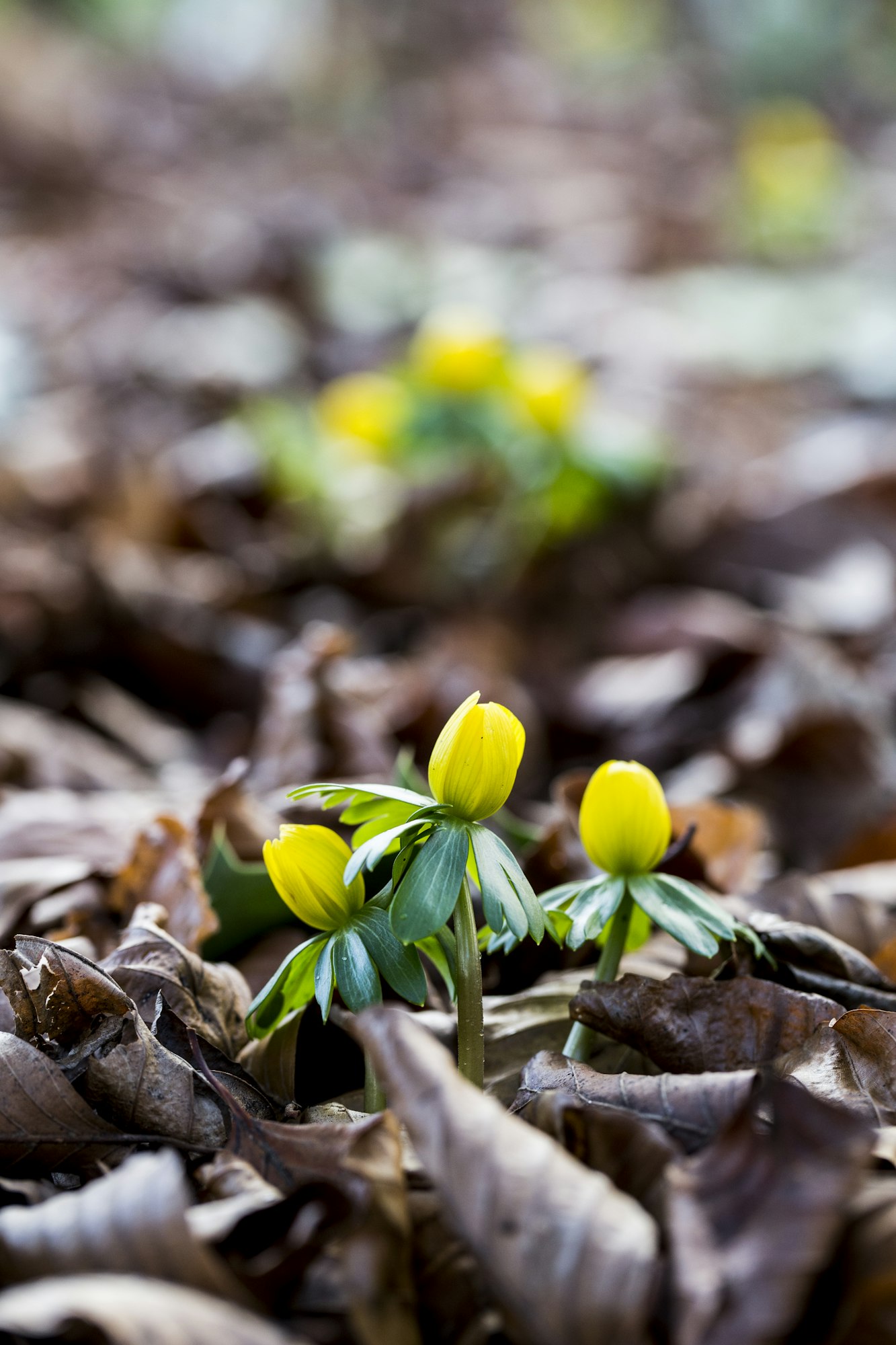
In the challenging climate of Zone 3, selecting the right flowers—those that can endure cold temperatures and make the most of a short growing season—is key to achieving a vibrant garden. Below is a list of annuals and perennials well-suited for Zone 3, along with planting and care tips to ensure they thrive.
Annuals for Zone 3
- Marigolds: Plant these sun-loving, frost-tolerant flowers after the last frost date. They require full sun and well-drained soil. Deadhead spent blooms to encourage continuous flowering.
- Petunias: Start indoors about 10 weeks before the last frost date or purchase seedlings to transplant after all danger of frost has passed. Petunias need full sun and moist, well-drained soil.
- Snapdragons: Start snapdragons indoors 8-10 weeks before the last frost. They can tolerate light frost, making them ideal for early spring and late fall blooms. Full sun to part shade and well-drained soil are best.
- Pansies: These can be planted in early spring and will bloom until the first hot spell. Pansies can also be planted in late summer for fall blooms. They prefer cooler temperatures, partial shade, and well-drained soil.
Perennials for Zone 3
- Peonies: Plant bare-root peonies in the fall for blooms the following spring. They require well-drained soil and full sun but can tolerate partial shade.
- Daylilies (Hemerocallis): Extremely hardy, daylilies thrive in Zone 3, blooming in mid to late summer. They prefer full sun to partial shade and well-drained soil.
- Hostas: Ideal for shady areas, hostas are hardy and low maintenance. Plant in spring or fall in moist, well-drained soil.
- Sedum (Stonecrop): These hardy succulents thrive in poor soil, require little water, and are perfect for Zone 3 gardens. Plant in full sun to partial shade.
Planting and Care Tips for Vibrant Blooms and Hardiness
- Soil Preparation: Amend the soil with compost or well-rotted manure to improve fertility and drainage before planting.
- Watering: Keep the soil consistently moist, especially during dry spells. However, avoid overwatering to prevent root rot.
- Mulching: Apply a layer of mulch around plants to retain moisture, suppress weeds, and keep root systems warm.
- Fertilization: Use a balanced, slow-release fertilizer in the spring to encourage healthy growth and vibrant blooms. Follow label instructions for specific plants.
- Deadheading: Regularly remove spent flowers, especially from annuals, to encourage more blooms and extend the flowering period.
- Protection: For perennials that are borderline hardy in Zone 3, consider applying a protective mulch layer in late fall to insulate the plants over the winter.
By choosing the right annuals and perennials for Zone 3 and following these care tips, gardeners can enjoy a beautiful and colorful garden that braves the cold and flourishes during the short summer. Remember, the key to success lies in selecting plants adapted to the local climate and providing them with the care they need to thrive.
Season Extenders for Zone 3

In Zone 3, where the growing season is notably short and frosts can occur well into spring and early in fall, utilizing season extenders can significantly increase your garden’s productivity and variety. Here are effective techniques and structures to extend your growing season, along with tips for maximizing plant growth and protection from frost.
Cold Frames
- Description: Cold frames are essentially mini-greenhouses that protect plants from cold weather. They are typically made with a wooden frame and a transparent top, which allows sunlight in while insulating the plants.
- Usage Tips: Place cold frames in a south-facing location to maximize sunlight exposure. Ventilate on sunny days to prevent overheating. Cold frames are ideal for hardening off seedlings in spring and extending the growing season for leafy greens and herbs in fall.
Greenhouses
- Description: Greenhouses provide a controlled environment for plants, protecting them from extreme weather while capturing solar heat.
- Usage Tips: Even unheated greenhouses can extend the growing season in Zone 3 by weeks or even months. Use for starting seeds early in the spring and for growing frost-sensitive plants. Ventilation is crucial to prevent overheating and humidity buildup.
Floating Row Covers
- Description: Made from lightweight, porous material, floating row covers lay directly over plants, creating a barrier against frost while allowing light, water, and air to penetrate.
- Usage Tips: Use floating row covers to protect plants from early and late-season frosts. They can also be used throughout the growing season to protect against pests. Secure the edges with soil or rocks to prevent wind from lifting the covers.
Mulching
- Description: Applying a thick layer of organic material on the soil surface around plants helps to regulate soil temperature, retain moisture, and protect roots from freezing temperatures.
- Usage Tips: Apply mulch in late fall to protect perennial plants over the winter. Straw, leaves, and wood chips are effective mulching materials. Remove or reduce mulch in spring to allow the soil to warm up.
Tips for Maximizing Plant Growth and Protection from Frost
- Start Seeds Indoors: Begin seeds indoors to get a head start on the growing season. Transplant outdoors when temperatures are suitable.
- Choose the Right Plants: Opt for cold-hardy and quick-maturing varieties that are more likely to produce a harvest within Zone 3’s short growing season.
- Monitor Weather Forecasts: Be prepared to cover plants or move containers indoors if a late spring or early fall frost is predicted.
- Utilize Thermal Mass: Water barrels or stones can absorb heat during the day and release it at night, helping to keep the area around plants warmer. Place these inside greenhouses or next to cold frames.
By incorporating these season extenders and strategies into your Zone 3 garden, you can protect your plants from the cold, start your growing season earlier, and extend it later into the fall. This not only increases your garden’s yield but also allows for a greater variety of plants to be grown in this challenging climate.
Monthly Maintenance Tips for Zone 3 Gardens
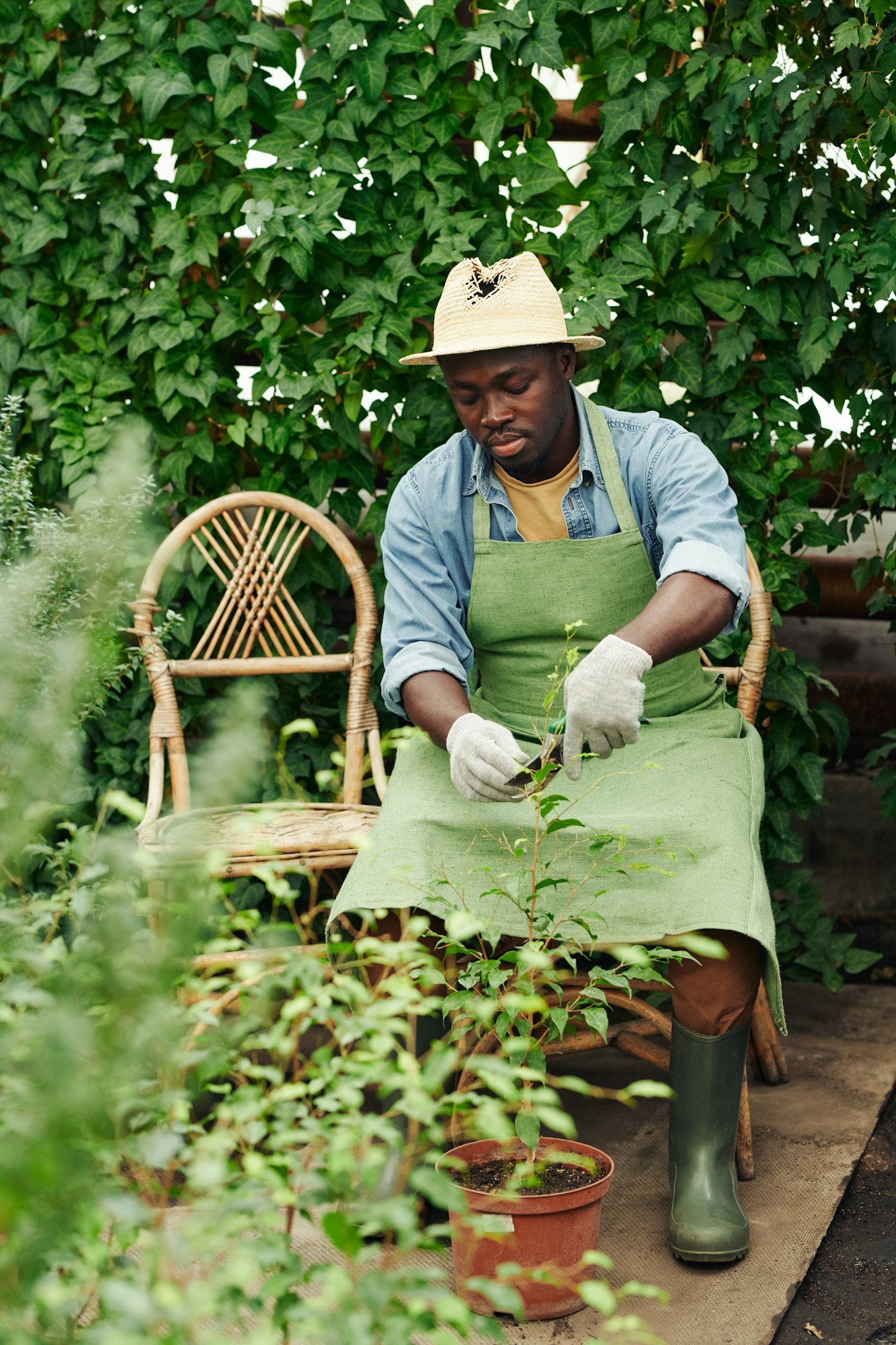
Zone 3 gardeners face unique challenges due to the short growing season and cold temperatures. Here’s a month-by-month checklist to help keep your garden thriving, along with a note on the importance of pest control and disease management.
April
- Start Seeds Indoors: Begin with frost-tolerant vegetables and flowers that can withstand the cold once transplanted.
- Prepare Garden Beds: As the ground thaws, clear debris and amend the soil with compost to enrich it before planting.
May
- Harden Off Seedlings: Gradually acclimate indoor-started plants to outdoor conditions.
- Transplant and Direct Sow: Begin planting frost-tolerant plants outdoors. Use row covers at night if frost is forecasted.
June
- Direct Sow Warm-Season Crops: Plant seeds for vegetables like beans, corn, and squash directly into the garden.
- Mulching: Apply mulch to conserve moisture, suppress weeds, and regulate soil temperature.
July
- Watering: Establish a regular watering schedule, especially important during warmer days.
- Pest and Disease Monitoring: Regularly inspect plants and take immediate action to mitigate any issues.
August
- Start Fall Crops: Sow seeds for cool-season vegetables such as kale, spinach, and radishes for a fall harvest.
- Continue Pest Control: Stay vigilant about pests and diseases, treating them as needed.
September
- Harvest: Begin harvesting mature crops. Protect late-season vegetables with row covers if early frosts are expected.
- Plant Perennials: Plant or divide perennials. This is also a good time to plant spring-blooming bulbs.
October
- Garden Cleanup: Remove spent annuals and vegetables to reduce overwintering pests and diseases.
- Mulch: Apply a protective layer of mulch around perennials and newly planted bulbs for winter protection.
November
- Tool Maintenance: Clean and store garden tools. Drain and store hoses and irrigation systems to prevent freezing.
- Plan for Next Season: Evaluate what worked and what didn’t in your garden. Start planning for next year.
December – March
- Order Seeds: Use this time to research and order seeds for the next growing season.
- Winter Projects: Build or repair garden structures like raised beds, trellises, or cold frames.
The Importance of Regular Pest Control and Disease Management
In Zone 3, the condensed growing season means that plants have less time to recover from setbacks caused by pests and diseases. Here are key strategies for maintaining a healthy garden:
- Early Detection: Regularly inspect your garden for signs of pests or diseases. Early intervention can prevent widespread damage.
- Integrated Pest Management (IPM): Use a combination of physical, biological, and chemical controls to manage pests and diseases with minimal environmental impact.
- Cultural Practices: Rotate crops, use resistant plant varieties, and maintain healthy soil to naturally reduce the risk of pests and diseases.
- Physical Barriers: Use row covers, nets, or collars around plants to physically prevent pests from reaching them.
By following this monthly maintenance checklist and prioritizing pest and disease management, gardeners in Zone 3 can maximize their garden’s productivity and enjoy a healthy, vibrant garden throughout the growing season.





